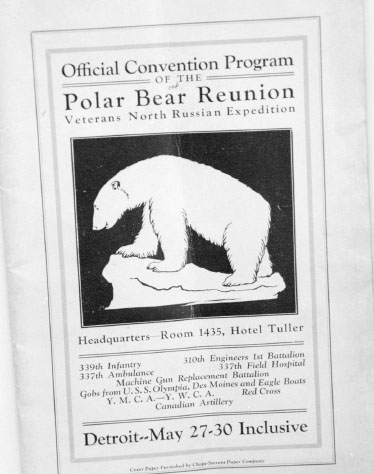The University Record, April 5, 1999
By Joanne Nesbit
News and Information Services

The current exhibit at the Bentley Historical Library sounds like it could be a documentary on arctic life, but the exhibit actually documents an episode of World War I involving an outfit dubbed The Polar Bears.
During the summer of 1918, the U.S. Army’s 85th Division, made up primarily of men from Michigan and Wisconsin, completed training at Fort Custer in Battle Creek, Mich., and proceeded to England. The 5,000 troops of the division’s 339th Infantry and support units realized that they were not being sent to France to join the great battles on the Western Front when they were issued Russian weapons and equipment and lectured on life in the Arctic regions.
When they reached their destination in early September, 600 miles north of Moscow, the men of the 339th joined an international force commanded by the British that had been sent to northern Russia for purposes that were never made clear. The Americans were soon spread in small fighting units across hundreds of miles of the Russian forest fighting the Bolsheviks who had taken power in Petrograd and Moscow.
The day of the Armistice (Nov. 11) when fighting ceased for other American armies, the allied soldiers were fighting the Bolsheviks said to be led by Trotsky himself. After three days, the allies finally were able to drive off the Bolsheviks. While this fight was a victory for the Americans, the battle led to the realization that the war was not over for these men. As the weeks and months passed and more battles were fought, the men began to wonder if they would ever get home.
The men of the 339th generally were well equipped with winter clothing during the winter of 1918-19 while stationed near the Arctic Circle, where temperatures reached minus 50 degrees Fahrenheit.
There was little daylight for months at a time. Knowing that the war was over for other American soldiers, the morale of the troops declined throughout the winter.
Families and friends of the men began to clamor for their return. Politicians unwilling to support an undeclared war against the Russian government joined in their demand. A petition to Congress was circulated. Several of the British and French units mutinied and refused to continue fighting. In early April, the American troops learned that they would be withdrawn as soon as the harbor at Archangel was cleared of ice.
It was not until June of 1919 that the men of the 339th sailed from Russia and adopted the polar bear as their regimental symbol. After a stop in New York, the troops went on to Detroit where they took part in a gala July 4 homecoming parade at Belle Isle.
“Michigan Boys Fighting the Bolsheviks: Archangel, 1918-1919” contains letters, diaries, photos, postcards and maps, some drawn by the men fighting in Russia. Newspaper clippings, and a petition to the Congress also is in the exhibit, curated by Leonard Coombs, an associate archivist with the Library’s Michigan History Collections. The exhibit will continue through May, but the artifacts contained in the exhibit are available after that time to anyone requesting to see them. The Library is open 8:30a.m.-5 p.m. Mon.-Fri. Coombs can be reached at 764-3482.

